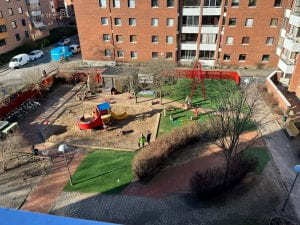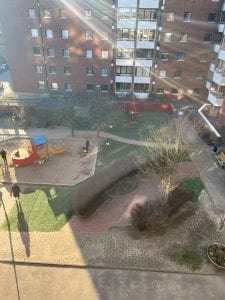In researching MKB for my previous post, I also wanted to learn more about our neighborhood and when these houses were constructed. While Sweden has a detailed Land Registry with lots of details about properties, it seems that you need a personnumber to access details. I dug a bit deeper and took a step back to better understand the Swedish approach to housing. I found out our housing was build in the 1970s.
Sweden experienced a population & economic boom following World War II and committed to an approach of improving the quality of housing and building public housing through municipally owned housing companies. The new housing had greenspace & parks and access to services (like preschools, shown below) integrated. Unlike many other countries, municipally owned housing is not means-tested meaning access isn’t limited by falling under a certain income threshold or paying a certain percentage of your income for housing. That means people of all incomes have access to publicly provided housing. Over half of renters in Sweden live in public housing. About 30% of people are renters. (As an aside, the cost of housing to buy seems very reasonable – approximately $400K for a 1100 square foot condo in the heart of the city. While it’s not easy to compare in this way, a quick search in Boston, a similar sized /quality apartment is at least double this price.) The lack of “means-testing” has become a critique of the Swedish approach to housing. This is something I want to learn more about – what if you’re under the income requirements and can’t find housing? Stockholm has famously long queues for apartments.
In 1965, due to the ongoing housing shortage, Sweden committed to building one million homes over 10 years through the famous ‘Million Homes Programme’. The intent was to provide higher quality housing and produce new housing to meet housing shortages. The construction was heavily subsidized for lower income housing.
Our neighborhood is called “Lugnet” and the name of our street translates to “calm street.” It is lined with 6 story buildings with courtyards, so this doesn’t necessarily align with the name of the street. I wanted to know more about this style of housing and when it was built. Digging deeper, I learned this:
The Lugnet district was originally a legendary working-class district in central Malmö, which was demolished to make way for a modern building. During the 1960s and 1970s, the simple street houses that have existed here since the middle of the 19th century were demolished. Our properties were built in 1979 and 1890.- MKB
Talking to locals and colleagues, everyone seems to have a slightly different take on whether demolition as good, bad, or necessary. Some say the homes were really cute and historic but others say the quality was poor and the homes were built in geologically compromised way. This site shares some of the history and controversy of demolishing the older, working class homes & neighborhood for new construction.
This website provides a lot of photos of the area before demolition: https://bilderisyd.se/produkt-tagg/lugnet.
Connecting this example to the U.S. context, the construction of this neighborhood serves as an example of what we call urban renewal where older, working class neighborhoods were demolished to build new post-war construction. In my own hometown of Frankfort, Kentucky, the “Crawfish Bottom” neighborhood was demolished to build a Civic Center & large state office building (which were recently demolished in 2018.) In this neighborhood, the result was more density in close access to the city center. Here in Sweden, the new Lugnet neighborhood was developed with consideration of childcare, greenspace, and serving older adults. It’s pretty remarkable to see the preschool inside our building (and across the street) so active all day and a mix of age groups living in the city center. In the U.S., we’ve started integrating services more in permanent supportive housing but it is far from the norm.
As I continue my research on land use, housing, and transportation, I want to better understand:
- What does land seizure/eminent domain look like in Sweden? (How do public agencies gain access to land?)
- Where is new housing being constructed? Is it infill or greenfield?
- How do people of all income levels access housing?


